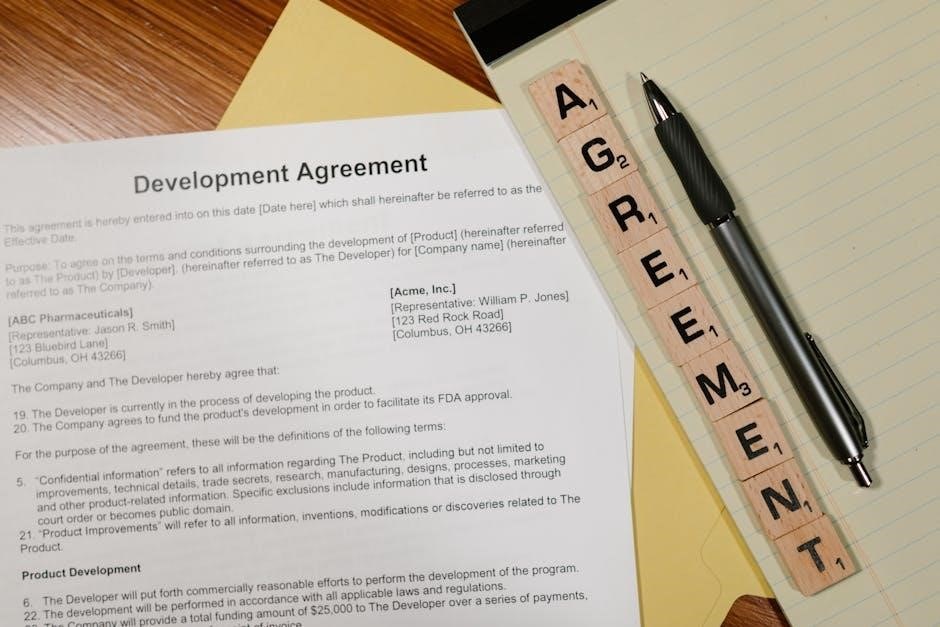Terms and conditions are legal agreements outlining the rules, rights, and obligations between service providers and users. They ensure compliance, protect both parties, and are adaptable to various business needs.
Purpose and Importance
Terms and conditions (T&Cs) serve as a foundational legal agreement between service providers and users, establishing clear guidelines for engagement. Their primary purpose is to outline the rights, responsibilities, and expectations of all parties involved, ensuring transparency and accountability. By defining the rules of use, T&Cs help protect both businesses and users from potential disputes, while also safeguarding intellectual property and limiting liability. They are essential for maintaining compliance with applicable laws and regulations, particularly in industries with strict legal requirements; Additionally, T&Cs provide a framework for resolving conflicts, such as payment disputes or termination of services, ensuring a fair and structured approach. Well-drafted terms and conditions not only minimize legal risks but also foster trust and confidence among users, creating a stable and professional environment for business operations.

Structure and Components
Terms and conditions typically include key clauses, standard provisions, and essential elements like payment terms, intellectual property rights, liability limitations, and user responsibilities, ensuring clarity and compliance.
3.1 Key Clauses
Key clauses in terms and conditions are essential for defining the legal framework of an agreement. They typically include intellectual property rights, outlining ownership of content and materials, and liability limitations, which protect the service provider from unforeseen damages. Payment terms specify how and when payments should be made, while termination clauses detail the conditions under which the agreement can be ended. Additionally, user responsibilities clarify the obligations of the user, ensuring compliance with the service provider’s rules. These clauses are designed to protect both parties and provide clarity on expectations. They also often address compliance with laws and dispute resolution processes, ensuring that all aspects of the agreement are legally sound and enforceable. By including these key clauses, terms and conditions ensure a balanced and transparent agreement for all involved.
3.2 Standard Provisions
Standard provisions in terms and conditions documents are fundamental sections that outline the basic rules and guidelines governing the use of a service or product. These provisions typically include payment terms, which detail how payments are to be made, and user responsibilities, which specify the obligations of the user. Additionally, standard provisions often cover compliance with laws, ensuring that both parties adhere to relevant legal requirements. They may also address changes to the agreement, outlining how updates to the terms and conditions will be communicated and implemented. Other common provisions include dispute resolution processes and governing law clauses, which establish the jurisdiction for resolving conflicts. These standard provisions provide a clear framework for understanding the rights and duties of all parties involved, ensuring transparency and legal compliance.
Legal Considerations
Legal considerations in terms and conditions ensure compliance with laws, protect intellectual property, and limit liability, while addressing user rights and obligations to maintain fairness and transparency for all parties involved.
4.1 Intellectual Property
Intellectual property clauses in terms and conditions are crucial for protecting the rights of both service providers and users. These clauses typically outline ownership of content, trademarks, copyrights, and other intangible assets. They ensure that the service provider retains ownership of their materials, while users are granted limited rights to use the content for specific purposes. Such provisions also address potential infringement issues, making it clear that the service provider does not warrant the non-infringement of third-party intellectual property rights. Users are often required to agree not to misuse or reproduce protected content without permission. These clauses help prevent disputes by establishing clear boundaries and responsibilities regarding intellectual property usage. By including these protections, terms and conditions ensure that both parties’ creative and proprietary rights are safeguarded throughout the agreement.
4.2 Liability Limitations
Liability limitations are essential clauses in terms and conditions that outline the extent of a service provider’s responsibility for damages or losses. These provisions aim to protect the provider by capping or excluding certain types of liability, such as indirect, incidental, or consequential damages. They often specify that the provider is not liable for issues arising from third-party actions, user negligence, or unforeseen circumstances. Liability limitations may also include disclaimers of warranties, either express or implied, ensuring users understand that services are provided “as is.” Such clauses are critical for managing risks and avoiding excessive financial exposure. By clearly defining these limitations, terms and conditions help establish a balanced agreement that protects both parties while encouraging responsible use of the service. These provisions are often carefully drafted to comply with applicable laws and ensure enforceability.
4.3 Compliance with Laws
Compliance with laws is a critical aspect of terms and conditions, ensuring that all parties adhere to relevant legal regulations. These clauses outline the legal framework governing the agreement, including local, national, and international laws. They specify that both the service provider and users must operate within the bounds of applicable legislation, such as data protection laws, intellectual property rights, and consumer protection regulations. Compliance clauses often require users to acknowledge that they understand and agree to abide by all relevant laws when using the service. This ensures that the service provider operates lawfully and that users are aware of their legal obligations. Such provisions are essential for maintaining trust, avoiding disputes, and ensuring that the service remains compliant with evolving legal standards. They also protect the provider from potential liabilities arising from non-compliance by users.

Drafting and Customization
Drafting terms and conditions involves tailoring agreements to meet specific business needs, ensuring clarity and compliance. Legal experts often assist in customizing templates to protect interests and avoid disputes effectively.
5.1 Tailoring to Specific Needs

Tailoring terms and conditions to specific needs ensures they align with the business model and industry requirements. This customization involves defining service scope, payment terms, and delivery timelines. For B2B or B2C models, clauses may differ to address distinct user responsibilities. Legal counsel plays a crucial role in adapting templates to comply with local laws and protect intellectual property. Businesses must also consider e-commerce specifics, such as digital payment terms and international shipping policies. By incorporating industry-specific provisions, companies can mitigate risks and ensure clarity for all parties involved. Regular reviews and updates are essential to maintain relevance and compliance with evolving regulations. Customization ensures the agreement is enforceable and balances the interests of both service providers and users effectively.
5.2 Seeking Legal Counsel
Seeking legal counsel is crucial when drafting or reviewing terms and conditions to ensure compliance with applicable laws and regulations. Legal experts can help tailor the document to the specific needs of the business while protecting intellectual property and limiting liability. They review clauses to ensure enforceability and clarity, reducing the risk of disputes. Legal counsel also provides guidance on including necessary provisions, such as compliance with data protection laws or international trade regulations. By involving legal professionals, businesses can avoid potential legal pitfalls and create a robust agreement that safeguards their interests. Regular legal reviews of terms and conditions are essential to adapt to changing laws and industry standards, ensuring the document remains relevant and effective over time.

Enforcement and Compliance
Enforcement and compliance are critical to ensuring that terms and conditions are upheld by all parties involved. Users must comply with all applicable laws, regulations, and the agreed-upon terms to maintain access to services. Service providers monitor adherence to these terms and may conduct audits to verify compliance. Failure to comply can result in penalties, termination of access, or legal action. Compliance also involves keeping records of user agreements and ensuring transparency in how terms are enforced. Regular updates to terms and conditions are necessary to reflect changes in laws or business practices. By enforcing these agreements consistently, service providers protect their rights and maintain a fair and lawful environment for all users. Compliance measures are essential for building trust and ensuring the smooth operation of services.
User Responsibilities
Users are required to fully comply with the terms and conditions and take responsibility for their actions while using the service. This includes providing accurate and complete information when requested, maintaining the confidentiality of their account credentials, and promptly notifying the service provider of any unauthorized use or security breaches. Users must also ensure that their activities comply with all applicable laws and regulations. By agreeing to the terms, users acknowledge that they are responsible for all actions taken under their account. Failure to meet these responsibilities may result in termination of access or legal consequences; Users are also expected to review and accept updates to the terms and conditions, as continued use of the service implies acceptance of any changes. Adhering to these responsibilities ensures a secure and lawful experience for all parties involved.

Changes and Updates
Service providers reserve the right to modify or update the terms and conditions at any time, with or without prior notice. Users are responsible for regularly reviewing the updated terms to ensure compliance. Changes may be made to reflect new laws, service modifications, or business needs. Continued use of the service after changes are implemented constitutes acceptance of the revised terms. Providers often notify users of significant updates through email or in-app notifications, but it is ultimately the user’s responsibility to stay informed. Failure to agree with new terms may result in termination of access or services. The updated terms will apply to all users equally, ensuring fairness and consistency in the agreement. Always check the “Last Updated” date at the bottom of the document to stay aware of the most recent changes.
Payment Terms
Payment terms outline the conditions under which payments must be made for services or goods provided. They specify acceptable payment methods, due dates, and any late payment fees. Users are typically required to pay in full by the agreed-upon deadline, and failure to do so may result in penalties or service suspension. Refunds are addressed in these terms, detailing eligibility and processes. Payment terms may also include provisions for recurring payments, such as subscriptions, and how changes to payment schedules will be communicated. It is the user’s responsibility to ensure payments are made in accordance with the agreed terms. These terms are designed to protect both parties by clarifying financial obligations and ensuring transparency in transactions. Payment processors or third-party services may have their own terms that users must also adhere to when making payments.

Dispute Resolution
Dispute resolution clauses outline the process for resolving conflicts that may arise between the service provider and the user. These terms often specify the methods for addressing disputes, such as arbitration, mediation, or litigation. The jurisdiction and governing law for resolving disputes are typically defined to ensure clarity and fairness. Users are generally required to attempt alternative dispute resolution before pursuing legal action. The terms may also include time limits for filing disputes and procedures for notifying the other party. Dispute resolution clauses aim to provide a clear framework for resolving conflicts efficiently and minimizing potential legal complications. By agreeing to these terms, both parties acknowledge the agreed-upon process for handling disagreements. This section is crucial for protecting the interests of both the service provider and the user while ensuring a fair and structured approach to conflict resolution.

Termination Clauses
Termination clauses outline the conditions under which either party can end the agreement. These clauses specify the circumstances, such as breach of terms, non-payment, or convenience, that allow termination. Notice periods are often required, detailing how many days one party must notify the other before termination takes effect. Automatic termination may occur if a material breach is not remedied within a specified timeframe. Post-termination obligations, like payment for services rendered or confidentiality agreements, are typically included. These clauses ensure clarity on how the relationship will be dissolved and what responsibilities remain after termination. They protect both parties by providing a structured process for ending the agreement, minimizing potential disputes. Properly drafted termination clauses are essential for maintaining legal certainty and ensuring a smooth conclusion to the business relationship if needed.

Third-Party Resources
Third-party resources refer to external services, tools, or content integrated into a platform or service. Their terms and conditions are governed by the provider’s own agreements, which users must adhere to. These resources may include software, APIs, or platforms used to enhance functionality. Users are typically bound by the third-party provider’s terms, which may differ from the primary service’s terms and conditions. For example, mobile app platforms often enforce their own terms on app usage. Compliance with these third-party agreements is essential to avoid violations or service disruptions. The primary service provider is not liable for third-party terms or actions, emphasizing the importance of reviewing their specific conditions. This ensures users understand their obligations when interacting with external resources within the service. Proper adherence to these terms maintains legal compliance and uninterrupted access to the service.
International Considerations
When drafting terms and conditions for international transactions, it is crucial to consider the legal frameworks of different jurisdictions. Laws vary significantly across countries, and compliance with international regulations is essential to avoid legal disputes. For instance, the European Union’s GDPR imposes strict data protection requirements, while other regions may have different privacy standards. Businesses must ensure their terms and conditions align with the laws of the countries where they operate. Additionally, international agreements, such as choice of law clauses, should be clearly defined to specify which jurisdiction’s laws will govern disputes. Localization of terms and conditions to meet regional legal standards is also important. Furthermore, businesses should address cross-border data transfers and ensure compliance with both home and foreign country regulations. Properly addressing international considerations ensures legal compliance and facilitates smooth operations in global markets.
Privacy Policies
Privacy policies are essential components of terms and conditions, outlining how personal data is collected, used, and protected. They ensure transparency and compliance with data protection laws, such as GDPR and CCPA. A well-drafted privacy policy informs users about their rights, including data access, correction, and deletion. It also specifies the legal basis for data processing and third-party sharing. Businesses must clearly define data security measures to safeguard user information and notify users of any data breaches. Compliance with international regulations is critical for companies operating globally. Privacy policies should be easily accessible and regularly updated to reflect legal changes or business practices. By including a privacy policy, organizations build trust with users and mitigate potential legal risks associated with data misuse. Ensuring clarity and adherence to privacy laws is vital for maintaining user confidence and avoiding penalties.

Best Practices
Best practices for drafting and implementing terms and conditions involve ensuring clarity, transparency, and legal compliance. Start by using clear and simple language to avoid ambiguity, making the document easily understandable for all users. Regularly review and update the terms to reflect changes in laws, business practices, or service offerings. Ensure that users are actively informed about updates, especially if changes affect their rights. Provide an easily accessible link to the terms and conditions on your website or platform. Consider including a summary or key points section to highlight critical clauses. Always involve legal counsel to tailor the document to your specific business needs and ensure compliance with local and international regulations. Finally, offer users the option to agree or opt out, fostering trust and accountability. By following these practices, you can create a robust and user-friendly terms and conditions document. This approach helps protect both your business and your customers while maintaining legal integrity.
Examples and Templates
Examples and templates for terms and conditions are widely available to help businesses draft comprehensive agreements. These templates often include standard clauses such as payment terms, intellectual property rights, and liability limitations. For instance, website terms and conditions templates typically cover user responsibilities, service descriptions, and dispute resolution processes. Service-based businesses may use templates that outline delivery timelines, cancellation policies, and refund procedures. Many resources, such as legal websites and business platforms, offer customizable templates tailored to specific industries or needs. Using these templates ensures consistency and compliance with legal standards. Additionally, tools like TermsFeed and PandaDoc provide interactive templates that can be adapted to fit various business models. By leveraging these examples and templates, businesses can create clear, enforceable terms and conditions that protect their interests while maintaining transparency with users. This approach saves time and reduces the risk of legal disputes.
In conclusion, terms and conditions are essential legal documents that outline the rules, rights, and obligations between service providers and users. They play a crucial role in protecting both parties by clarifying expectations and minimizing potential disputes. By incorporating key clauses such as payment terms, intellectual property rights, and liability limitations, businesses can ensure compliance with legal standards and maintain transparency. Customizable templates and examples available online make it easier for organizations to draft tailored agreements that suit their specific needs. Regular updates and clear communication of changes are vital to keep these documents relevant and enforceable. Ultimately, well-crafted terms and conditions foster trust and accountability, benefiting both businesses and their users. They are a cornerstone of legal and operational efficiency in today’s digital and commercial landscapes.
